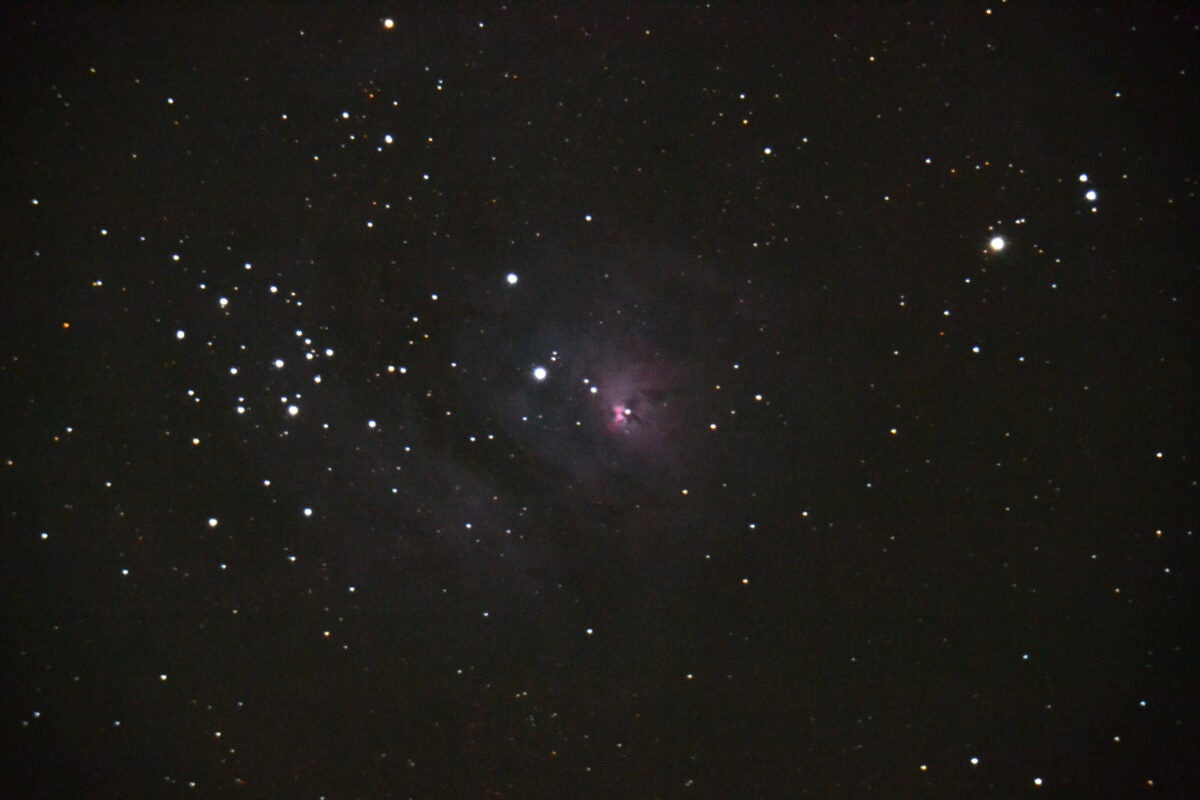To perfectly frame objects in your field of view, you'll need to know your telescope's focal length and a little math.

My first image of the Lagoon Nebula (M8) was so magnified that the object didn't look like a lagoon at all. I took it with a Nikon D3100 on my 8-inch Celestron SCT telescope, with an exposure time of 30 seconds at ISO 3200. Credit: Molly Wakeling
The first night I went out with my new Celestron NexStar 8SE back in July 2015, I knew little about the relative sizes of astronomical objects. I was stunned by my first glimpse of Saturn—a stunning view through an 8-inch Schmidt-Cassegrain telescope (SCT)—and was eager to see more.
I knew the view through the telescope wouldn’t be like the images I’d seen on the Internet, but when I headed toward the Lagoon Nebula (M8), all I could see were stars, with no trace of nebulosity at all. On my third night out, using a newly acquired T-adapter to attach my DSLR to the telescope, I took a 30-second exposure and was finally able to see the colorful nebula. But it filled the entire frame and looked nothing like the images I’d seen. “Why?” I wondered.
Focal length and field of view
An important number associated with every telescope is its focal length, or the distance light travels after passing through the objective to the eyepiece or camera. This number is usually expressed in millimeters (mm). For example, my 8-inch SCT has a focal length of 2032mm. Think of it as a massive 2000mm camera lens!
This number can also be expressed by the focal ratio, or f-number. Unlike camera lenses, telescopes do not have irises to reduce the effective aperture, so the focal ratio is simply the focal length divided by the aperture. On my 8-inch telescope, which has a metric aperture of 203 mm, the focal ratio is f/10. Another example is my 106 mm f/5 refractor, which has a focal length of 106 × 5 = 530 mm.
People who attend stargazing events often ask me what my magnification is. But when framing a particular object in the eyepiece or image, the most useful value is the field of view (FOV), or how large an area of the sky you can see with the telescope and a given camera or eyepiece.
The quick and easy calculation for a camera is FOV = 3.436 × (sensor dimension) ÷ (focal length), where sensor dimension is the length or width of your camera’s sensor in millimeters, and focal length is also in millimeters. The result is the FOV in arcminutes; divide by 60 to get degrees. For a Nikon DSLR with an APS-C (cropped) sensor, with dimensions of 23.6mm by 15.7mm, the FOV of my 8-inch SCT is then 39.9′ by 26.5′, or 0.67° by 0.44°. For an eyepiece, FOV = (apparent FOV of eyepiece) × (focal length of eyepiece) ÷ (focal length of telescope).
There are also online calculators; my favorite is https://astronomy.tools/calculators/field_of_view.
Choosing your goal
Now that you’ve calculated your field of view, you can figure out which targets will be too big, too small, or a perfect fit. You can find object sizes on apps like SkySafari or online—the Lagoon Nebula, for example, measures 90′ by 40′. With a field of view of 39.9′ by 26.5′, it’s no wonder I couldn’t see much of it in my image—the field of view is too small! It would make a much better target for my 530mm focal length refractor.
On the other hand, there are many galaxies and planetary nebulae that appear tiny in my refractor but are perfect for my Schmidt-Cassegrain; for example, the peculiar galaxy Arp 273 is only 1.4′ by 0.3′ in size, but looks great in my Celestron 9.25 Edge HD with a focal length of 2,345 mm.
Now that you have a better understanding of the effects of different focal lengths, you can plan images for your telescope and camera or eyepiece combination. A great resource for finding targets of a certain size (among many other criteria) is the Imm Compendium, an impressive and detailed spreadsheet by astrophotographer Gary Imm, which can be found at https://tinyurl.com/imm-compendium.
Happy hunting!